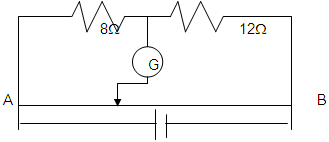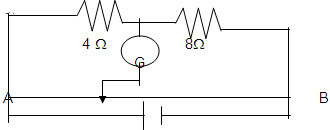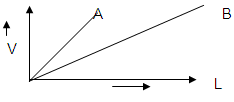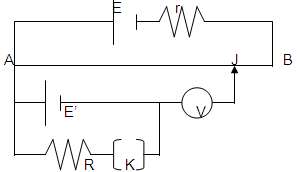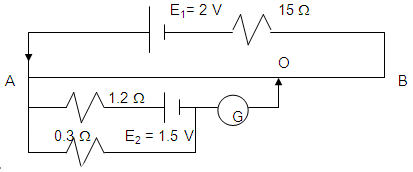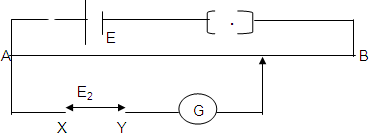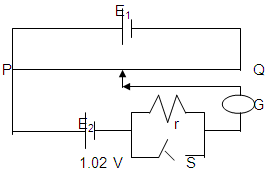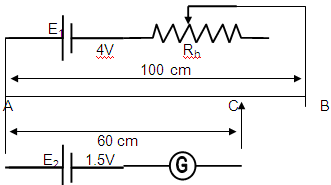![]()
CBSE Guess > Papers > Important Questions > Class XII > 2011 > Physics > Physics By Mr.Ashis kumar satapathy
CBSE CLASS XII
Potentiometer
A: Following questions are very short answer type. They are to be answered in one or two sentences. They may carry one mark each.
- Name the device used for measuring the internal resistance of a secondary cell.
B: The following questions are of short answer type. Each of them may carry 2 or 3 marks.
- Describe with the help of a circuit diagram how a potentiometer can be used to compare EMF's of two cells?
- Two cells of EMF E1 and E2( E1 > E2 ) are connected as shown in the fig. When a potentiometer is connected between A and B, the balancing length of the potentiometer is
300 cm. On connecting the same potentiometer between A and C, the balancing length is found to be 100cm. Calculate the ratio of E1 and E2.
- Explain the working principle of a potentiometer. How will you find the value of the EMF of an electric cell using a potentiometer?
- You are required to find the internal resistance of a primary cell in the laboratory. Draw the circuit diagram of the circuit you will use to determine it. Explain the principle of the experiment. Give the formula used.
- Why is a potentiometer preferred over a voltmeter to measure EMF of a cell? The potentiometer wire AB shown in the figure is 400 cm long.12 Ω Where should the free end of the galvanometer be connected so that deflection in the galvanometer is zero?
- State the principle of a potentiometer. The potentiometer wire AB shown in the figure is 600 cm long. Where should the free end of the galvanometer be connected so that the galvanometer shows zero deflection ?
- The variation of p.d. V with length L in two potentiometer A and B is as shown in fig.Explain which is more sensitive ?
- Explain the principle on which the working of a potentiometer is based. Why is the use of a potentiometer preferred over a voltmeter for measurement of EMF of a cell?
- Measuring EMF's of cells, a potentiometer is preferred over a voltmeter. Why? The length of a potentiometer wire is 5 metres. It is connected to a battery of constant EMF. For a given For Leclanche Cell, the position of zero galvanometer deflection is obtained at 100 cm. If the length of the potentiometer wire be made 8 metres instead of 5 metres, calculate the length of the wire for zero deflection in galvanometer for the same Leclanche Cell.
- There exists a constant potential difference between the two ends of a potentiometer wire. Two cells are connected, in turn, in such a way that they
(I) help each other and
(ii) oppose each other and are balanced on the potentiometer wire at
(I) 120 cm and
(ii) 60 cm length respectively. Calculate the ratio of the EMF of the two cells.- Explain with help of a circuit diagram, the use of potentiometer for determination of internal resistance of a primary cell. Derive the necessary mathematical expression.
- The following circuit shows the use of potentiometer to measure the internal resistance of a cell:
(i)When the key K is open, how does the balance point change, if the current from the driver cell decreases?
(ii) When the key is closed, how does the balance point change if R is increased, keeping the current from the driver cell constant?
- In the circuit diagram given below AB is a uniform wire of resistance 10 ohms and length 1m. It is connected to a series arrangement of cell E1 of emf 2.0V and negligible internal resistance and a resistor R. Terminal A is also connected to an electrochemical cell E2 of emf 100 mV and a galvanometer G. In this set-up balancing point is obtained at 40 cm mark from A. Calculate the resistance R. If the E2 were to have an emf of 300 mV where will you expect the balancing point to be?
- With help of a labeled circuit diagram, explain how will you compare the emfs of two primary cells using a potentiometer. State the formula used.
- AB is 1 meter long uniform wire of 10 ohms resistance. The other data are as shown in the circuit diagram given below. Calculate
(i) potential gradient along AB, and
(ii) length AO of the wire, when the galvanometer shows no deflection.- The length of a potentiometer wire is 600 cm and it carries a current of 40 mA. For a cell of emf 2 V and internal resistance 10 ohm, the null point is found to be at 500 cm. If a voltmeter is connected across the cell, the balancing length is decreased by 16 cm. Find the
(i) resistance of the whole wire,
(ii) reading of the voltmeter and
(iii) resistance of the voltmeter.- Define potential gradient. Using this concept, explain the method for comparison of emfs of two primary cells using a potentiometer. Establish the relation used. Write two possible causes of potentiometer giving one sided deflection in this method.
- For the potentiometer circuit shown in the given figure, points X and Y represent the two terminals of an unknown emf E. A student observed that when the jockey is moved from the end A to the end B of the potentiometer wire, the deflection in the galvanometer remains in the same direction. What are the two possible faults in the circuit that could result in this observation?
- 19. If the galvanometer deflection at the end B is
(i) more
(ii) less than that at the end A, which of the two faults, listed above, would be there in the circuit? Give reasons in support of your answer in each case.- the circuit diagram shows the use of a potentiometer to measure a small emf produced by a thermocouple connected between X and Y. The cell C, of emf 2 V, has negligible internal resistance. The potentiometer wire PQ is 1.00 m long and has resistance 5 Ω. The balance point S is found to be 400 mm from P. Calculate the value of emf V, generated by the thermo-couple.
- Potentiometer wire PQ of 1m length is connected to a standard cell E1. Another cell, E2 of emf 1.02 V is connected as shown in the circuit diagram with a resistance ‘r’ and a switch, S. With switch, S open, null position is obtained ata d distance of 51 cm from P.Calculate the
(I) potential gradient of the potentiometer wire,
(ii) emf of the cell E1 and
(iii) When switch S is closed, will null point move toward P or Q? Give reason for your answer.
- What is meant by the sensitivity of a potentiometer. A battery E1 of 4V and a variable resistance Rh are connected in series with the wire AB of the potentiometer. The length of the potentiometer wire is 1 meter.When a cell E2 of emf 1.5V is connected between points A and C,no current flows through E2. Length AC = 60 cm.
(I) Find the potential difference between the ends A and B of the potentiometer.
(ii) Would the method work if the battery E1 is replaced by a cell of emf 1 V?
- The potentiometer wire of length 100cm Has a resistance of 10 Ω. It is connected In series with a resistance 5 Ω and an Accumulator of emf 3 V having Negligible internal resistance. A Source of 1.2 V is balanced against Length ‘L” of the potentiometer wire. Find the value of L.,
Submitted By Mr.Ashis kumar satapathy
Email Id :[email protected]
